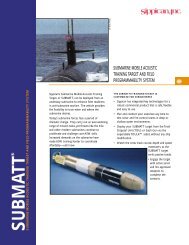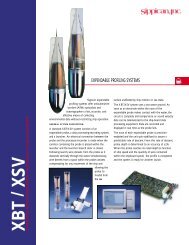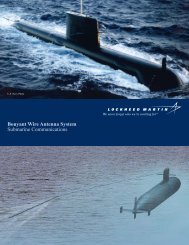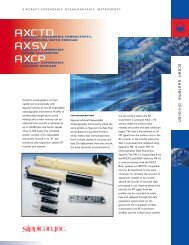OE-538/BRC Multifunction Communication Mast Antenna System
OE-538/BRC Multifunction Communication Mast Antenna System
OE-538/BRC Multifunction Communication Mast Antenna System
Create successful ePaper yourself
Turn your PDF publications into a flip-book with our unique Google optimized e-Paper software.
<strong>OE</strong>-<strong>538</strong>/<strong>BRC</strong><br />
<strong>Multifunction</strong> <strong>Communication</strong><br />
<strong>Mast</strong> <strong>Antenna</strong> <strong>System</strong><br />
Photo by Rick Thompson, Northrop Grumman Newport News
<strong>OE</strong>-<strong>538</strong>/<strong>BRC</strong><br />
<strong>Multifunction</strong><br />
<strong>Communication</strong><br />
<strong>Mast</strong> <strong>Antenna</strong> <strong>System</strong><br />
<strong>Antenna</strong><br />
Control Unit<br />
(Unit 5)<br />
Photo by Chris Oxley, Northrop Grumman Newport News<br />
If the communication<br />
antennas in use aboard your submarine<br />
do not satisfy your current or future<br />
requirements, you need to consider<br />
replacing those antennas with a modern,<br />
highly capable <strong>Multifunction</strong> <strong>Mast</strong><br />
<strong>Antenna</strong> (MFM) system. Lockheed<br />
Martin offers standard MFM antennas<br />
and custom variations to meet your<br />
specific communications requirements<br />
The <strong>OE</strong>-<strong>538</strong>/<strong>BRC</strong> <strong>Antenna</strong><br />
was designed and is manufactured for<br />
the U.S. Navy by Lockheed Martin.<br />
It is a high performance, mastmounted,<br />
communication and navigation antenna<br />
intended for new construction or as<br />
a replacement upgrade for antennas<br />
on existing submarines. The standard<br />
<strong>OE</strong>-<strong>538</strong>/<strong>BRC</strong> system supports<br />
communications in several operating<br />
bands including VLF/LF receive<br />
(10 kHz to 170k Hz), MF/HF Transceive<br />
(2 MHz to 30 MHz), VHF LOS Transceive<br />
(30 MHz to 174 MHz), VHF/UHF LOS<br />
Transceive (225 MHz to 400 MHz),<br />
VHF/UHF SATCOM Transceive<br />
(240 MHz to 400MHz), IFF Transpond<br />
<strong>OE</strong>-<strong>538</strong><br />
<strong>Antenna</strong><br />
(Unit 1)<br />
and GPS receive. The MF/HF capabilities<br />
include both conventional narrowband<br />
and broadband tuning modes and requires<br />
no adjunct external tuning equipment.<br />
When used for satellite communications,<br />
the antenna is capable of full duplex<br />
UHF Demand Assigned Multiple Access<br />
(DAMA) communications with UFO<br />
and MILSTAR (LDR) satellites.<br />
Variants of the <strong>OE</strong>-<strong>538</strong>/<strong>BRC</strong><br />
have been developed which also<br />
support Iridium transceive and Link-16<br />
transceive communications and improved<br />
MF/HF and VHF/UHF STACOM<br />
communications performance. These<br />
features can be added to the antenna<br />
without sacrifice to the submarine’s<br />
other communications capabilities.<br />
Junction<br />
Box<br />
(Unit 4)<br />
Hull<br />
Penetrator<br />
(Unit 3)<br />
External<br />
Cable<br />
(Unit 2)<br />
<strong>OE</strong>-<strong>538</strong> system units.<br />
The individual antennas of<br />
the <strong>OE</strong>-<strong>538</strong>/<strong>BRC</strong> system are housed in a<br />
hydrodynamically faired, nonpenetrating<br />
mast assembly. The system is capable of<br />
simultaneous transmission and reception<br />
for all functions. The spatial coverage is<br />
excellent, allowing communication<br />
from low angle, line of sight assets<br />
to high and low angle satellite assets.<br />
The external mast is an extremely<br />
rugged hydrodynamically optimized<br />
assembly, allowing use from a submerged<br />
submarine operating at high speeds<br />
and in severe weather and sea-state<br />
conditions. With its compact and modular<br />
design, the <strong>OE</strong>-<strong>538</strong> antenna offers all<br />
of these capabilities in a smaller volume<br />
than any competitive solution.<br />
The <strong>OE</strong>-<strong>538</strong>/<strong>BRC</strong> <strong>Antenna</strong> is a high<br />
performance, mast-mounted, communication<br />
and navigation antenna intended for new<br />
construction or as a replacement upgrade<br />
for antennas on existing submarines.
The <strong>OE</strong>-<strong>538</strong>/<strong>BRC</strong> <strong>Antenna</strong><br />
<strong>System</strong> comprises five units. Unit 1,<br />
the <strong>Antenna</strong>/Radome Assembly, is a<br />
pressure-proof radome that houses all<br />
required antenna elements and associated<br />
outboard electronics. Unit 5, the <strong>Antenna</strong><br />
Control Unit (ACU), provides control<br />
of the <strong>Antenna</strong>/Radome Assembly and<br />
the RF input/output ports for external<br />
receivers and transceivers. Units 2, 3<br />
and 4 provide connectivity between the<br />
antenna/radome and the ACU.<br />
The antenna/radome contains<br />
four higher frequency antenna elements<br />
(HF/VHF, UHF, IFF and GPS) utilized<br />
for the capture and transmit of RF<br />
signals. Signals are routed to and from<br />
these antenna elements via appropriate<br />
matching networks, bandpass filters, and<br />
amplifiers. All RF signals are multiplexed<br />
onto a single, coaxial RF line by diplex<br />
filter units. VLF/LF reception is<br />
accommodated via a VLF/LF crossed<br />
loop antenna with integral preamplifiers.<br />
The VLF/LF signals appear on a<br />
dedicated set of signal lines at the base<br />
of the antenna. Operating power, control<br />
and status information to and from the<br />
antenna radome is routed to and within<br />
the radome via separate, dedicated<br />
conductors. The RF, VLF/LF and power/<br />
control/status signals are routed through<br />
a single connector at the base of the<br />
antenna/radome to the external cable<br />
assembly (Unit 2) and then to the hull<br />
penetrator (Unit 3). The Junction Box<br />
(Unit 4) may be mounted either directly<br />
at the hull penetrator or within seven feet<br />
of the penetration point. The Junction<br />
Box provides for distribution of the VLF/<br />
LF and other antenna/radome signals.<br />
<strong>Antenna</strong> RF signals and control/<br />
status signals are routed from the Junction<br />
Box to the ACU. The ACU separates<br />
the single, RF signal into four separate<br />
signals: HF/VHF, UHF, IFF and GPS. It<br />
also provides for both local and remote<br />
control of the <strong>Antenna</strong>/Radome Assembly<br />
and for presentation of the system status<br />
on front panel system status displays or<br />
at a remote location via a control/<br />
monitoring port. The remote control<br />
presently utilized is an RS-422 port.<br />
Alternately, a different bus controller<br />
port, such as an RS-232 port, can be<br />
implemented if requested.<br />
Lockheed Martin has over<br />
35 years of dedicated experience in<br />
the field of submarine communications.<br />
Our background and experience in the<br />
development of antennas and associated<br />
couplers in the ELF through UHF range<br />
has led to our being recognized as the<br />
world leader in submarine antenna<br />
systems. This background and experience<br />
assures you that Lockheed Martin can<br />
provide custom variations of their<br />
standard MFM systems to meet your<br />
specific communication needs and the<br />
physical requirements of your submarine<br />
and its environment.<br />
The <strong>OE</strong><strong>538</strong>/<strong>BRC</strong> system is capable<br />
of simultaneous transmission and<br />
reception for all functions.<br />
<strong>Antenna</strong> <strong>System</strong> Performance<br />
Power Handling<br />
Function<br />
Band of Operation<br />
Polarization<br />
Radiation Pattern<br />
Azimuth<br />
Elevation<br />
Capacity<br />
VLF/LF Receive<br />
10 kHz - 170 kHz<br />
Vertical Linear<br />
Crossed<br />
Figure-8<br />
HF Transceive 2 MHz - 30 MHz Vertical Linear Omni<br />
VHF Transceive 30 MHz - 174 MHz Vertical Linear Omni<br />
UHF LOS Transceive 225 MHz - 400 MHz Vertical Linear Omni<br />
UHF SATCOM Transceive 240 MHz - 400 MHz Circular Omni<br />
Similar<br />
to Monopole<br />
Similar<br />
to Monopole<br />
Similar<br />
to Monopole<br />
Similar<br />
to Monopole<br />
Hemispherical<br />
(See Note 1)<br />
Receive Only<br />
1 KW<br />
100 W<br />
200 W<br />
200 W<br />
IFF Transpond 980 MHz - 1120 MHz Vertical Linear Omni<br />
Similar<br />
to Monopole<br />
1 KW Peak<br />
1227.6 MHz + 10 MHz<br />
GPS Receive<br />
Circular Omni Hemispherical Receive Only<br />
1575.42 MHz + 10 MHz<br />
Note 1: <strong>System</strong> provides both high angle and low angle modes for SATCOM operation. Elevation pattern is hemispherical in either<br />
mode, but gain is optimized at high (30° to 90° elevation) or low (horizon to 30° elevation) angles.
©2006<br />
Lockheed Martin Corporation<br />
All Rights Reserved<br />
Lockheed Martin MS2<br />
Seven Barnabas Road<br />
Marion, MA 02738<br />
An ISO9001:2000 Company<br />
Sea-Air <strong>System</strong>s<br />
1(508)748-1160 (x138)<br />
e-mail: douglas.q.williams@lmco.com<br />
JUNE2006/NDCR/20060007/Covers:2006
















